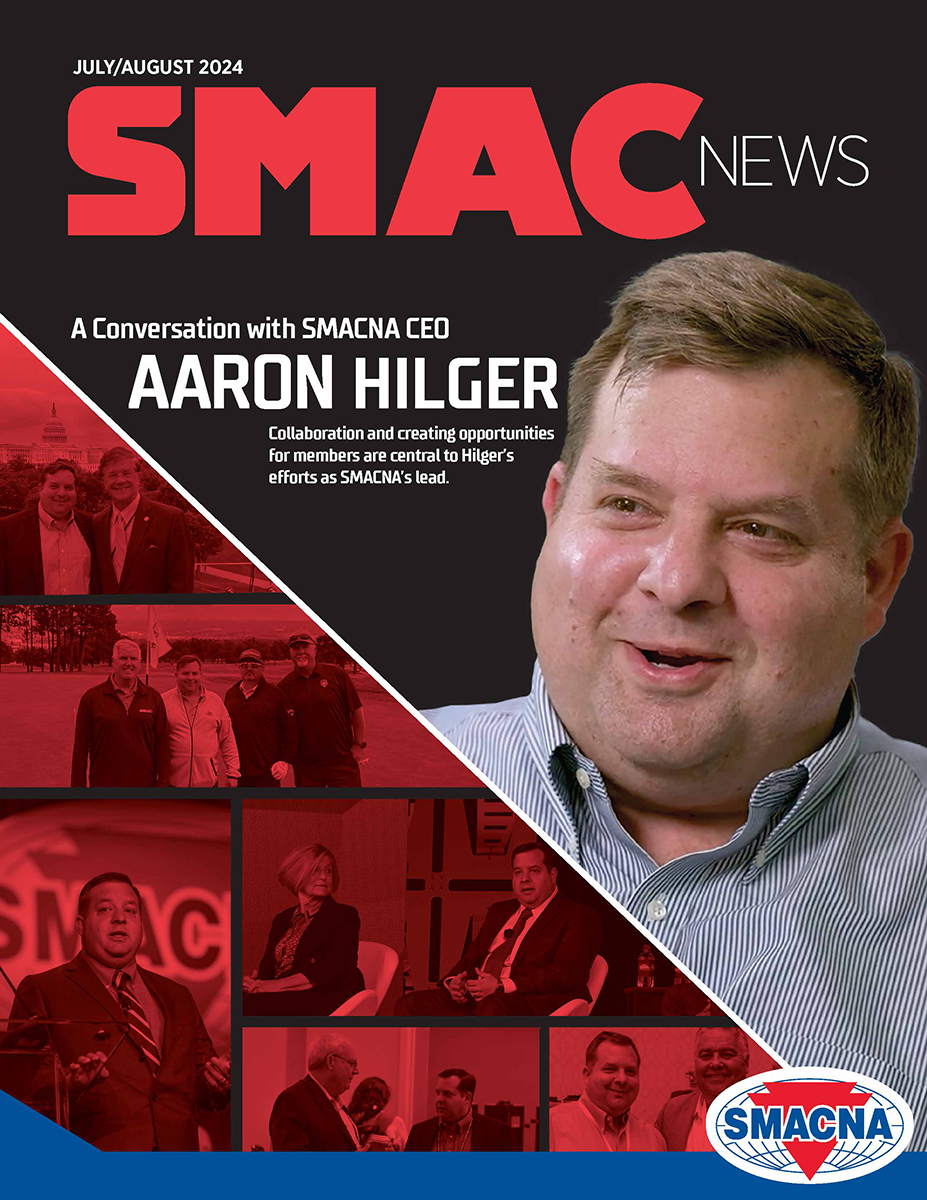How to Build a Local Mentoring Program
Mentorships can nurture talent and strengthen your sheet metal and HVAC business.
 In today's competitive market, recruiting and retaining skilled workers in the sheet metal and HVAC industry is more challenging than ever. The demand for skilled labor is high, yet the supply of qualified candidates often falls short.
In today's competitive market, recruiting and retaining skilled workers in the sheet metal and HVAC industry is more challenging than ever. The demand for skilled labor is high, yet the supply of qualified candidates often falls short.
This talent shortage is compounded by an aging workforce, with many experienced professionals nearing retirement and fewer young workers entering the trades. As a result, companies are finding it increasingly difficult to attract new talent and keep their current employees engaged and committed.
Recruiting new employees involves significant time and financial resources. The process of identifying, interviewing and onboarding suitable candidates can be lengthy and costly, often with no guarantee of success. Even when new hires are successfully brought on board, the challenge doesn’t end there. Retaining these employees is equally, if not more, crucial. High turnover rates can disrupt workflow, lower morale and lead to substantial financial losses. According to a study by the Society for Human Resource Management (SHRM), the average cost per hire is more than $4,000, and losing an employee can cost a company up to six to nine months of an employee’s salary on average.
In such a demanding environment, traditional methods of recruitment and retention are no longer sufficient. Companies need innovative strategies to attract and keep top talent. One highly effective approach is implementing a structured mentoring program. Mentorship provides a powerful solution to many of the challenges faced by sheet metal and HVAC employers. By pairing experienced professionals with less experienced employees, mentoring can bridge the skills gap, foster a culture of continuous learning and create a more engaged and committed workforce.
At the Partners in Progress conference in February, Lisa Davis, Administrator of the National Energy Management Institute (NEMI), and Tammy Meyen, Recruitment and Retention Specialist at the International Training Institute (ITI), spoke about mentoring’s impact on employee retention and profitability. Mentorship programs offer numerous benefits that can significantly enhance both recruitment and retention efforts, they say. For new recruits, the presence of a mentor provides a welcoming and supportive introduction to the company, helping them acclimate more quickly and feel valued from day one. For existing employees, mentorship offers ongoing opportunities for professional development, making them more likely to stay with the company long-term. In fact, a strong mentoring program can transform a workplace into a thriving environment where employees are motivated, skilled, and ready to contribute to the company’s success.
By understanding and implementing these mentorship strategies, companies can not only overcome the challenges of recruitment and retention but also foster a more robust and resilient workforce, ultimately strengthening the entire industry.
THE IMPORTANCEOF MENTORING
Mentoring is more than just passing on skills; it is about fostering relationships, building confidence and inspiring growth. In the sheet metal and HVAC industries, where precision, expertise and continuous learning are critical, mentoring plays a crucial role in ensuring that the next generation of workers is well-prepared and highly competent.
What can mentoring do? Let’s start with skills transfer and knowledge retention. According to the American Society for Training and Development (ASTD), companies with mentoring programs report higher knowledge transfer and retention rates. In industries like sheet metal and HVAC, where much of the expertise is hands-on and experiential, mentoring ensures that seasoned professionals pass on their valuable knowledge to less experienced employee. This not only preserves institutional knowledge but also maintains high standards of work quality.

On average, companies with mentoring programs had profits that were 18% better than average, while those without mentoring programs had profits that were 45% worse than average.
Mentoring also builds confidence and professional growth for junior employees, Davis and Meyen explain. It provides them with a support system and a sounding board for their ideas and concerns. This supportive environment encourages continuous learning and professional growth. In fact, having clear development pathways helps employees see a future with the company.
This sense of progression and personal development can significantly reduce turnover rates, as employees are more likely to remain with an organization that invests in their growth. This is crucial considering $1 trillion is lost annually to turnover due to the expenses associated with recruiting and training new employees. Mentorships improve retention rates by fostering that sense of belonging and commitment. In fact, “when asked the question, ‘In the last three months, have you seriously considered quitting your job?’ those with mentors thought about saying, ‘Yes,’ less,” Davis explains. “When employees feel supported and valued, they are more likely to stay with the company long-term. This can lead to a more stable, experienced workforce.”
A study by the Harvard Business Review supports this, finding that employees who participate in mentoring programs report higher job satisfaction and organizational commitment.
Effective mentoring programs can also have a positive impact on a company's bottom line. By improving employee retention and enhancing skill levels, mentoring can lead to increased productivity and reduced costs. On average, companies with mentoring programs had profits that were 18% better than average, while those without mentoring programs had profits that were 45% worse than average, Davis and Meyen point out.
Mentored employees also tend to be more productive and produce higher quality work. This is because they receive continuous guidance and feedback, helping them to develop their skills more effectively. As a result, companies can achieve higher levels of efficiency and customer satisfaction, leading to increased profitability.

"Mentoring is a reciprocal and collaborative learning relationship between two or more individuals with mutual goals and shared accountability for the success of the relationship."
— Lois Zachary
“Effective mentoring is a powerful tool for fostering growth and development,” says Kathy Kram, an expert in mentoring and developmental relationships at Boston University. “It benefits not only the individuals involved but also the organization as a whole by building a more skilled, committed and engaged workforce.”
BUILDING A MENTORSHIP PROGRAM
Creating a successful mentoring program involves careful planning and execution. Here are the key steps to building an effective program.
- Define program objectives. Start by defining the objectives of the mentoring program. These objectives should align with the company’s overall goals and address specific needs within the organization. Common objectives include improving skill levels, enhancing employee retention and fostering leadership development.
- Identify potential mentors and mentees. Select mentors who have significant experience and a willingness to share their knowledge. Mentors should be skilled in their trade and possess strong communication and interpersonal skills. Identify mentees who can benefit from the program, such as new hires, apprentices or employees looking to advance their careers. “Keep numbers small for human connection,” Davis recommends.
- Develop a structured plan. Create a structured plan that outlines the mentoring process, including timelines, meeting frequencies and key milestones. The plan should also define the roles and responsibilities of both mentors and mentees, ensuring that expectations are clear.
- Provide training and resources. Equip mentors with the training and resources they need to be effective. This might include training on communication and coaching techniques, as well as access to tools and materials that support skill development. Providing ongoing support for mentors is also crucial to ensure they can fulfill their roles effectively.
- Match mentors and mentees. Carefully match mentors and mentees based on their skills, experience and goals. Consider conducting interviews or surveys to understand the preferences and expectations of both parties. A good match is essential for building a strong mentoring relationship. As Lois Zachary, a leading authority on mentoring, notes, “mentoring is a reciprocal and collaborative learning relationship between two (or more) individuals with mutual goals and shared accountability for the success of the relationship.”
- Monitor progress and provide feedback. Regularly monitor the progress of the mentoring relationships and provide feedback to both mentors and mentees. This can involve periodic check-ins, surveys or formal evaluations. Address any issues or challenges that arise promptly to ensure the program remains effective.
MANAGING THE MENTORSHIP PROGRAM
Effective management is crucial to the long-term success of a mentoring program. Davis and Meyen suggest considering some of these areas for perfecting the program management.
- Establish clear metrics. Define clear metrics to evaluate the success of the mentoring program. These might include retention rates, employee satisfaction scores, skill development progress and overall productivity improvements. Regularly review these metrics to assess the program’s impact.
- Foster a supportive culture. Create a company culture that supports and values mentoring. Encourage open communication and collaboration. Davis suggests having a monthly lunch meeting to answer questions from the entire mentee group at once and keep engagement high. Remember to recognize the efforts of mentors and mentees. A supportive culture can help sustain the mentoring program and ensure its success.
- Adapt and improve. Continuously seek feedback from participants and make necessary adjustments to improve the program. Stay informed about best practices in mentoring and be willing to adapt your approach based on what works best for your organization.
- Celebrate successes. Managing a mentorship program can be a lot of work, Davis and Meyen attest, which is why celebrating the successes and milestones achieved through the program is important. This can include recognizing outstanding mentors and mentees, sharing success stories and highlighting the positive impact of the program on the company.
INVESTING IN MENTORSHIP REAPS REWARDS
Building a local mentoring program for sheet metal and HVAC contractors is an investment in the future of your company and the industry as a whole.
By nurturing talent and fostering a culture of continuous learning and support, you can enhance employee retention, improve profitability and ensure the long-term success of your organization.
With careful planning, effective management and a commitment to continuous improvement, a mentoring program can become a cornerstone of your company’s development strategy, driving growth.
Published: August 26, 2024
IN THIS ISSUE
A Beacon of Modern Healthcare
McClure Co. brings its healthcare facility expertise to Penn Highlands State College Hospital and Medical Office Building.
A Better (Water) Way
Poynter Sheet Metal installed 213,000 pounds of ductwork in an underground tunnel as part of a project to prevent the release of hazardous wastewater into nearby rivers.
A Conversation with SMACNA CEO Aaron Hilger
Collaboration with labor partners, creating opportunities for members, and addressing the workforce challenges of the future are some of the featured topics in this sitdown with SMACNA's head.
Emotional Intelligence is a Key Ingredient for Building a Culture of Respect
Culture of Respect (formerly BE4ALL, Belonging and Excellence for All) launched in December 2021.
Expand Your Knowledge to Grow
One of the core parts of SMACNA's mandate is to educate our member contractors on the evolving landscape of our industry.
How to Build a Local Mentoring Program
Mentorships can nurture talent and strengthen your sheet metal and HVAC business.
Lights, Camera, Restoration
Canadian SMACNA contractor Heather & Little brings back the shine to a historic house from Hollywood’s golden age.
Navigating the Changing Landscape
Construction and A&E industries show optimism and resilience in 2024.
Our Evolving Industry
Believe it or not, we are already preparing for the SMACNA Annual Convention in Palm Desert, California.
SMACNA Releases 4 Updated Guides
New editions offer important updates to help SMACNA contractors advance their knowledge.
SMACNA Supports 'Long Overdue' Workforce Quality & Skill Training Reqs on Federal IRA Projects
SMACNA applauds the final rule issued by the Biden Administration that is designed to address the skilled workforce crisis shortage by requiring private developers to comply with Project Labor Agreements (PLAs) and Prevailing Wage and Apprenticeship
SMACNA, NECA, MCAA and TAUC in Strategic Alliance
New agreement between organizations designed to develop and expand best practices, safety standards and encourage technological advancements across the entire union construction space.
Supreme Court Decision Curbs Agency Discretion
On June 28, the U.S. Supreme Court issued a decision that will have far-reaching consequences for federal agencies. Specifically, in Loper Bright Enterprises v. Raimondo, the Supreme Court ended four decades of deference to federal agencies’ leeway
The Residential HVAC Market Is Heating Up
A 2024 market report highlights growing opportunity in the residential HVAC sector. Veterans HVAC Owner David Giacalone addresses energy efficiency, regulatory requirements and consumers’ demand for high-end systems.
Welcome New SMACNA Members
Welcome New SMACNA Members




